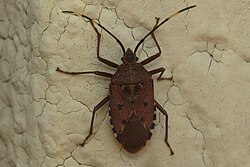Biology:Urostylididae
| Urostylididae | |
|---|---|

| |
| Urochela quadrinotata | |
| Scientific classification | |
| Domain: | Eukaryota |
| Kingdom: | Animalia |
| Phylum: | Arthropoda |
| Class: | Insecta |
| Order: | Hemiptera |
| Suborder: | Heteroptera |
| Superfamily: | Pentatomoidea |
| Family: | Urostylididae Dallas, 1851 |
| Genera | |
| |
Urostylididae is a family of true bugs and is considered a basal or "primitive" family within the stink-bug lineage. They are found only in Asia. Older works used the spelling Urostylidae but this clashes with the name used for a protozoan family and a spelling correction (emendation) has been suggested that also avoids the confusion created by homonyms. The family name Urolabididae has also been used for some members in the past.[1]
This family has about 100 species, with distribution limited mainly to eastern Asia. Urostylidids are 4 to 15 mm and somewhat longer than broad with elongated legs, three tarsal segments, and a small head. The antenna has 5 segments of which the first is longer than the head. The base of the antenna has broad tubercles and has a ringed appearance. The simple eyes or ocelli, when present (Urolabida lacks ocelli[2]), are very close to each other. They show a wide separation between the hind and mid coxae on the underside. Other important family characters are the presence of a structure for stridulation, the stridulitrum on the first anal vein of the hind wing, and bristles on the claws. The female genital structure has nine gonocoxites that form a M or W-shaped sclerite.[3] They suck plant sap.[4][5] The male reproductive anatomy suggests close affinities to the Tessaratomidae subfamily Natalicolinae. The spermatheca has two pump flanges in two genera which is a feature found also in the Aradidae and Leptopodidae. Thus the phylogeny of the group is unclear but lies within the Pentatomoidea.[6] In the past the family was divided into two subfamilies, but one group, the Saileriolinae, has since been suggested as a distinct family, Saileriolidae, by at least two studies. The position of Saileriolidae within the Pentatomoidea is still unclear.[3][7]
References
- ↑ Berger, H.; Heiss, E.; Kerzhner, I.M. (2001). "Removal of homonymy between Urostylidae Dallas, 1851 (Insecta, Heteroptera) and Urostylidae Buetschli, 1889 (Ciliophora, Hypotrichia)". Annalen des Naturhistorischen Museums in Wien 103B: 301–302. http://www.landesmuseum.at/pdf_frei_remote/ANNA_103B_0301-0302.pdf.
- ↑ Distant, WL (1902). Fauna of British India. Rhynchota. Volume 1. London: Taylor and Francis. p. 303. https://archive.org/stream/rhynchota01dist#page/302/mode/1up.
- ↑ 3.0 3.1 Grazia, Jocelia; Schuh, Randall T.; Wheeler, Ward C. (2008). "Phylogenetic relationships of family groups in Pentatomoidea based on morphology and DNA sequences (Insecta: Heteroptera)". Cladistics 24 (6): 932–976. doi:10.1111/j.1096-0031.2008.00224.x. PMID 34892882. http://www.ndsu.edu/pubweb/~rider/Pentatomoidea/PDFs/G/Grazia_Schuh_Wheeler_2008a.pdf.
- ↑ Schuh, Randall T.; Slater, James Alexander (1995). True Bugs of the World (Hemiptera:Heteroptera): Classification and Natural History. Cornell University Press. pp. 245–246.
- ↑ Ren, Shu-Zhi; Lin, Cheng-Shing (2003). "Revision of the Urostylidae of Taiwan, with descriptions of three new species and one new record (Hemiptera-Heteroptera: Urostylidae)". Formosan Entomologist 23: 129–143. http://digi_lib.entomol.ntu.edu.tw/chinese/publication/journal/pdf/t2302/t230204.pdf.
- ↑ Kumar, R. (1971). "Morphology and relationships of the Pentatomoidea (Heteroptera) 5-Urostylidae". American Midland Naturalist 85 (1): 63–73. doi:10.2307/2423912.
- ↑ Yao, Yunzhi; Cai, Wanzhi; Rider, David A.; Ren, Dong (2012). "Primipentatomidae fam. nov. (Hemiptera: Heteroptera: Pentatomomorpha), an extinct insect family from the Cretaceous of north-eastern China". Journal of Systematic Palaeontology 11: 1–20. doi:10.1080/14772019.2011.639814.
Wikidata ☰ Q4006498 entry
 |

